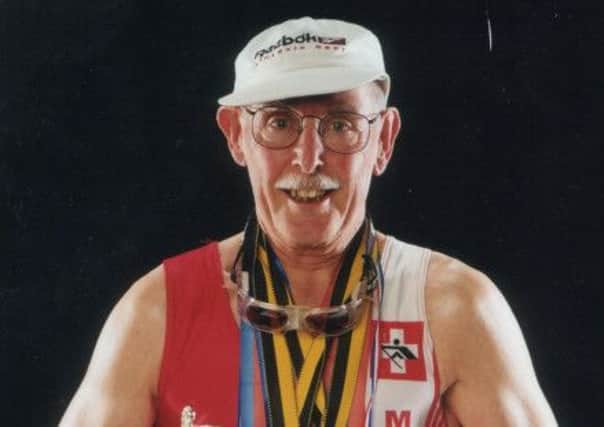With the right knowledge, we can become fitter
This article contains affiliate links. We may earn a small commission on items purchased through this article, but that does not affect our editorial judgement.


Former bank clerk Dorothy McLennan is a champion pole vaulter, heptathlete and sprinter. What makes her unusual is that she is 77, and only took up athletics professionally in her 50s.
Charles Eugster, a bodybuilder and rower, took part in three events last year: the World Masters Rowing Regatta in Italy, the World Masters Athletics Championships in Brazil and the European Strenflex Championships in Switzerland. He took up sport at the age of 85, he says, to attract the “sexy young 70-year-olds on the beach” and is now 93 (he looks 20 years younger).
Advertisement
Hide AdAnd, out of a field of 2,500 at the BUPA Great Edinburgh Cross Country Run this month, there were 421 over 50s – that’s almost a fifth. The oldest were two men aged 77.
Why, then, for the rest of us, does keeping fit as we get older feel like such a slog? The weight takes longer to budge in our forties than it did in our twenties. It sometimes feels as though our metabolism has stopped in its tracks. Are we just making excuses? Yes, says personal trainer Will Sturgeon.
“According to the renowned Mayo Clinic in Florida, thermogenesis (the body’s food processing part of our metabolism) stays relatively steady throughout life.”
He adds: “With the right knowledge and enthusiasm, we can become fitter and leaner as we age.”
Contrary to our complaints, our metabolism doesn’t simply ‘slow down’ as we age; rather as our lives change, our exercise changes and our preferences change.
“The more we sit at a desk, the less active we become,” says Sturgeon. “It can be small changes over the years, but that adds up to a lot of calories not burned and muscle wastage. Studies suggest one per cent of muscle can burn up to 40 calories per day. That’s 1,240 calories a month, almost half a pound of fat. But one per cent of muscle can easily be lost.”
Advertisement
Hide AdOur willingness to perform heavy, energy-sapping exercise also decreases over the years, he says. “As we age, we almost convince ourselves that a ‘little walk or cycle is better than nothing’.”
Nikki Gibson, an exercise physiologist with SportScotland, helping train elite athletes, triathletes and swimmers, agrees – to a point. “In terms of the body changing, there’s a definite physical decline. Your aerobic capacity reduces about ten per cent over a decade, irrespective of your fitness level, so a 70-year-old marathon runner would definitely be fitter than a 70-year-old who doesn’t run marathons but they’re probably not going to be fitter than a 20-year-old who doesn’t do any training.
Advertisement
Hide Ad“There’s also a natural decline in the size of your muscles – from 50 years onwards this can be between one and two kilos per decade. When that goes, that reduces the amount of power we can produce and that can make exercise more difficult and everyday tasks more difficult.”
On top of that, she adds, the chemical changes in the brain mean that we are less motivated to exercise as we get older. “There could be a slight alteration in neurotransmission from the dopamine system which may reduce your desire to exercise.”
The plus side, however, is that you’re never too old to start. “Adapting is still possible as we age,” says Gibson. “So if a 65-year-old does 12 weeks of strength training they will see an improvement in the size of their muscles, the capabilities of their muscles and their endurance performance. With that we’re also going to get an increase in quality of life and it will offset other negative health consequences.”
That means we will be less likely to fall victim to things like heart disease and stroke but also, in more simple terms, the more efficient our muscles are, the less likely we are to trip and fall while carrying out simple, everyday tasks.
For Sturgeon, the advice is simple: “Stay well hydrated,” he says. “Dehydration is the most common cause of daytime fatigue. And once you feel thirsty, you’re already dehydrated.”
Add to that a good, protein-rich diet, and don’t be scared of tougher workouts. “During weights workouts, lift substantial weights – eight to ten reps a set is great. During aerobic training, aim higher up your training zone. And, if possible, try and keep a close eye on your body’s muscle and fats using body composition tests.”
Advertisement
Hide Ad“If you’re going into a gym,” cautions Gibson, “it’s always important to seek expertise from someone who works there, who can advise on how to stay active and healthy without injuring yourself. But it doesn’t have to be as complex as that. Going out for a walk can be enough. The health guidelines are for five 30-minute walks a week. I think most individuals are capable of doing that.”
• Will Power Personal Training (07714 340068, facebook.com/willpowerpersonaltraining), SportScotland (sportscotland.org.uk)